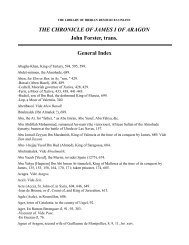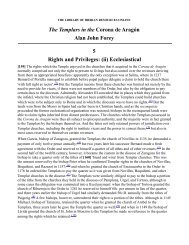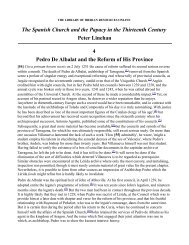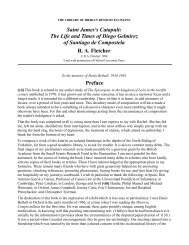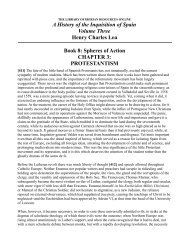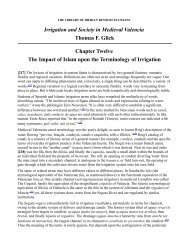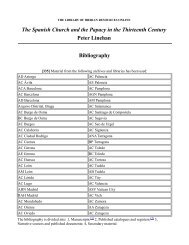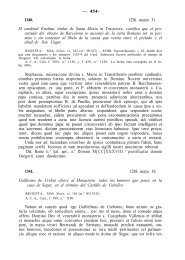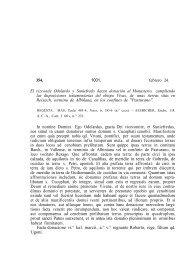Chapter 6 - The Library of Iberian Resources Online
Chapter 6 - The Library of Iberian Resources Online
Chapter 6 - The Library of Iberian Resources Online
You also want an ePaper? Increase the reach of your titles
YUMPU automatically turns print PDFs into web optimized ePapers that Google loves.
picaresque novel Lazarillo de Tormes. (12) In the midst <strong>of</strong> all the accusations and countercharges it is<br />
not surprising that one poor beggar <strong>of</strong> the city, Bartolomé Fuentes, declared that God would not lower<br />
Himself to the hands <strong>of</strong> undignified clergymen. This was too much for the Inquisition, which subjected<br />
him to public penance in an auto de fé on December 22, 1560. (13)<br />
Clerical reform might "purify" the clergy, but it also served political purposes. Both Church and Crown<br />
were concerned with controlling ideology, and the Church was a strong competitor that showed<br />
disturbing tendencies to act independently. Recognizing that clerical reform could curb this competitor,<br />
Philip II readily came to the assistance <strong>of</strong> Cardinal Archbishop de Castro when he needed help<br />
reforming his clergy in Seville. Clerical dissension was a timely excuse for the Crown's imposition <strong>of</strong><br />
restraint on the power, wealth, and independence <strong>of</strong> the Church. To many people clerical reform was<br />
simply an extension <strong>of</strong> central control over more members <strong>of</strong> the clergy, a device to ensure that the<br />
Church would be a tool <strong>of</strong> the secular government.<br />
Cynicism about priests as intermediaries increased in the sixteenth and seventeenth centuries as Seville<br />
became a major center <strong>of</strong> an heretical sect, the Alumbrados. <strong>The</strong>se religious mystics taught that direct<br />
union with God was possible without [123] a priestly intermediary. <strong>The</strong> nuns, monks, and secular<br />
clergy who belonged to the sect acted as spiritual counselors rather than intermediaries. Mysticism was<br />
also an important part <strong>of</strong> the devotional exercises <strong>of</strong> Jesuits and followers <strong>of</strong> Saint Teresa <strong>of</strong> Avila and<br />
Saint John <strong>of</strong> the Cross, but these groups accepted the discipline <strong>of</strong> the Church and did not pose the<br />
serious Alumbrado challenge to priests. Churchmen like Pedro de León tried to distinguish the "false<br />
mysticism" <strong>of</strong> the Alumbrados from the "true mysticism" <strong>of</strong> loyal Christians, but their arguments<br />
seemed mere hair-splitting to many people. (14)<br />
<strong>The</strong> Alumbrados also increased cynicism about priests because they provided such tantalizing stories<br />
about sexual irregularities accompanying religious ecstasies. Tongues wagged about the Alumbrado<br />
monk, Brother Juan de Jesús María, who convinced another monk and a young girl that he could<br />
communicate the spirit and love <strong>of</strong> God to them through his embraces and kisses. Asserting that they<br />
could not be guilty <strong>of</strong> sin because they were in a close state with God, he urged that the three make a<br />
spiritual union through the flesh. Francisco Mendez, an Alumbrado preacher, provided another juicy<br />
tale when the Inquisition charged him with dancing with a group <strong>of</strong> beatas after Mass and working<br />
them up into such a frenzy that they fell down with their legs uncovered. <strong>The</strong> Inquisition attempted to<br />
root out salacious heretics like these, but their prosecutions also helped to publicize the scandalous<br />
tales. (15)<br />
Alumbrados held a special appeal for the women <strong>of</strong> Seville. Many noble women <strong>of</strong> the city were<br />
followers <strong>of</strong> Padre Mendez, who may be the Francisco Mendez mentioned above. He stayed at the<br />
Franciscan monastery in the city, and on some mornings more than thirty carriages waited there for<br />
women who had come to pray and consult with him. An anonymous letter from Seville in 1623 asserted<br />
that the greater part <strong>of</strong> the city was infected with the Alumbrado heresy, "and especially the women."<br />
[124] Though some <strong>of</strong> these women were nuns and beatas, many were the wives and daughters <strong>of</strong><br />
respectable local aristocrats. It was reported that when the Church <strong>of</strong>fered pardons to all who would<br />
denounce themselves as Alumbrados, so many women responded that twenty notaries and twenty<br />
inquisitors were not enough to handle all the confessions. More than 5000 pardons were issued in 1624<br />
for this heresy in the Archbishopric <strong>of</strong> Seville. (16) <strong>The</strong> mass confession revealed not only the extent <strong>of</strong><br />
the heresy but also the willingness <strong>of</strong> many to conform ideologically to the teachings <strong>of</strong> the institutional<br />
Church. It suggests that the ladies <strong>of</strong> Seville gained attention by indulging in a little mysticism and<br />
confession <strong>of</strong> heresy. Religious mysticism was one <strong>of</strong> the few ways they could protest the priestly and<br />
secular authorities who so rigidly controlled their lives. In addition, mystical experiments and<br />
confession <strong>of</strong> heresy <strong>of</strong>fered the emotional intimacy and adventure so lacking in the lives <strong>of</strong> these




